Theo Verelst Local Diary Page 36
I've ditched the usual header for the
moment, I think it doesn't help much anyhow.
This page is copyrighted by me, and may be read and transfered by any
means only as a whole and including the references to me. I
guess thats normal.
Sun Nov 26 17:51, 2006
Gosh I was behind in my diary page writing, not that I
made real promises I'd make them in a certain tempo, but one has to be
true to oneself, even when the law appears to be that no-one responds,
even though the server serves more than a CD full of data to china (or
where ever its going) per
week, and in fact last month the server fed the world with 10 GIGA byte
(thats 10 million megabytes or about 2 full DVDs) of files from my
disc, about 20 files every hour (average)...
The MILE 2006 presentation poster
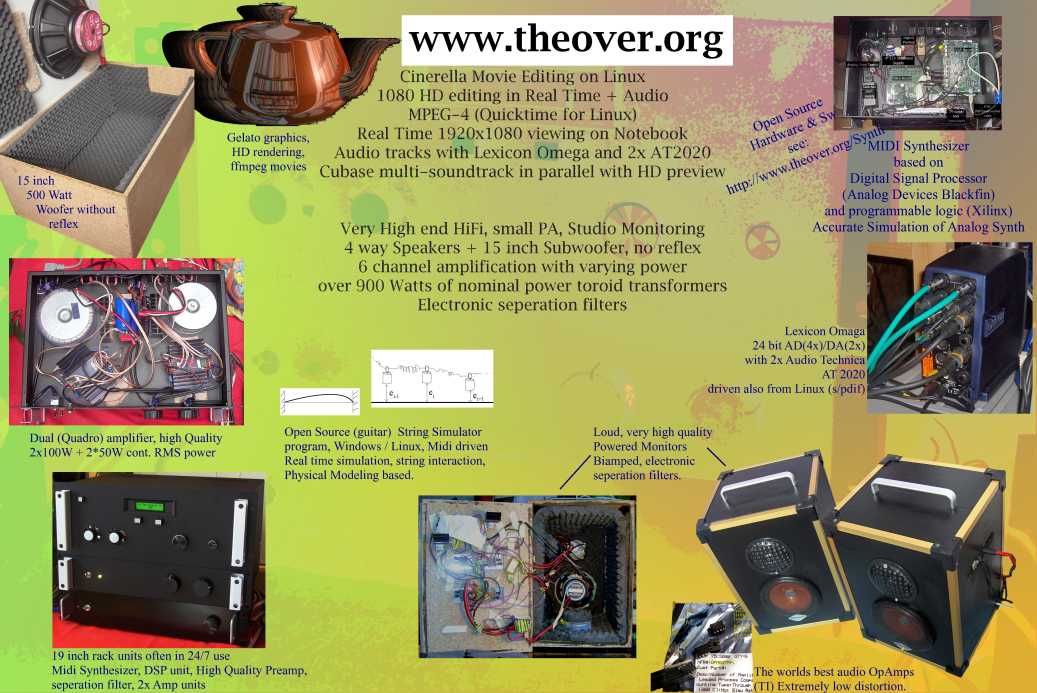
The above picture (see here
for a bit bigger, and here
for the 6.5 megabyte large original which is about 18 MegaPixels large)
was turned into a 50x75 cm poster for presentation at the MILE2006
largest yearly dutch musical equipment fair along with my (updated) set
of prototype speakers, amplifiers and synthesizer, and a notebook
capabele of editing High Definition Video (and 24 bit audio) with a
fairly large screen to demonstrate cinelerra on.
The poster was printed by a department store for not very much money,
and looked very good, it was prepared in High Dynamic Range (HDR) using
CinePaint (on windows or Linux) which is nice to do. HDR means more
bits per pixel in a computer image such as a jpeg image than the usual
maximum of 8 bits per color, for intance 16 bits per color (makes
3x16bits=6 bytes per RGB pixel, or 8 bytes for images with
transparency). an't photoshop do this already for years ? Possibly it
could even 7 years ago, though slowly, but this is an open source
package available for windows and Linux, works pretty fast on a fast
machien, and it is fun to play with contrast and such on a very acurate
format image. Even bigger fun can be the editing of cinema related
images, frames from a film or from a HD film, also possible in high
colour accuracy, which makes large dynamic range pictures more real,
less compressed, and in general images will look smoother and show no
'banding' in small gradient areas and after processing with image
effects. Most clearly, the effect of more sample accuracy is space for
changing contrast and brightness and saturation without limiting or
inaccuracy artifacts. Unfortunately, for this HEMA print, I had to
convert back to JPG image format in the end, but I have tried a smaller
test image with AH which I uploaded as a huge file to the printer in 16
bit TIFF format, but I am not sure they don't convert themselves to a 8
bit format on their web service pipeline somewhere.
Fedora Core 5 and 6
Recently I've downloaded and installed fedora core5 and 6/64 bit on
different machines, both with windows as second OS remaining on the
disc, so one can chose at startup time which operating system to use,
and both machines are dual core machines, which works good.
Fedora is the followup of Redhat Linux which I used and installed in
the past on various machines, and its the more up to date and open
source and free OS of redhat, which also sells redhat enterprise linux.
fedora core X (1 to 6) are free for download, and I was able to use a
fast (consumer) internet connection which let me download the whole DVD
in about an hour, and burn, media check and MD5 check it in another
half hour or so. Thats good for having such a cool and powerfull unix
variation available.
Here is a screenshot of the core 6 gnome desktop running various
programs after it had been installed in I guess an hour or so, though I
first had to make space on the harddisk by resizing a ntfs partition
using in one case a CD and in the other case a specially formatted USB
stick for automatic startup at boot time with PARTED on it, that worked
good thus far:

The machine I put FC6 on is a dual core pentium 3GHz with fast chipset
and 1 Gig memory and a sata 250 G disc and a nvidia 6700XL graphics
card, and I found out it recognized my Lexicon USB AD/DA converter and
of course such a fast machine makes then an excellent audio
workstation, especially since it also runs jack (about 5mS delay),
Rosegarden, Adoura, Audigy, DSSI- Hexter and Fluidsynth and the great
sounding zynsubFX, and the LADSPA audio processing plugins.With a very
good AD/DA converter this leads to in fast a pretty well sounding whoe,
which is certainly not in every respect rock stabe., although Linux is
a lot more stable than windows and it is possible to tune the used
programs and jack settings to optimize latency or interaction between
the various sprograms.
That whole is pretty powerfull from harddisk audio and midi recording
to waveform processing sample, additive, subtractive and FM synthesis
(Hexter is a DX7 simulator) and quite a few audio effects of varying
quality, most musica, and some excellent (like the plate reverb). Viva
open source music software it is at least is not dead and limited like
most windows audio modules. Real music is quite possible it appears.
Also visible on the screen dump is DX an IBM visual programming
environment with image and 3D processing modules, like I've in the past
used and described in previous pages. Celestia contains a large
database of celestial bodies and can show 3D visualisations of space,
which looks great.
On FC6 there is no cinelerra available for yum (an automatic installer)
download yet to my knowledge, so I used a self compiled FC4 64 bit
version whic I copied to the FC6 machine with all needed library files,
and it works, though it seems not to make efficient use of the dual
cores.
On Core 5 I have a good cinelerra working, which is able to even show
HD material (I'm talking 1080) almost in real time frame for frame 25
frames/sec in the editor, in full 1920x1080 pixels resolution, that's
great.
Also that machine runs Gelato (on windows and on Linux) which I can
call from from Blender because someone made a script for that, and I
have experimented using Gelato rendered image sequences to creat HD
movies with, and mixed it with HD camera recorded footage.
I've compiled a program from the Kino website which allows the reading
of mpeg 2 transport stream data from a firewire interface, which allows
me to preview 1080 HD streams in full resolution in real time (a second
delay or so) with mplayer through a unix pipe or even remotely over a
ethernetwork (!).
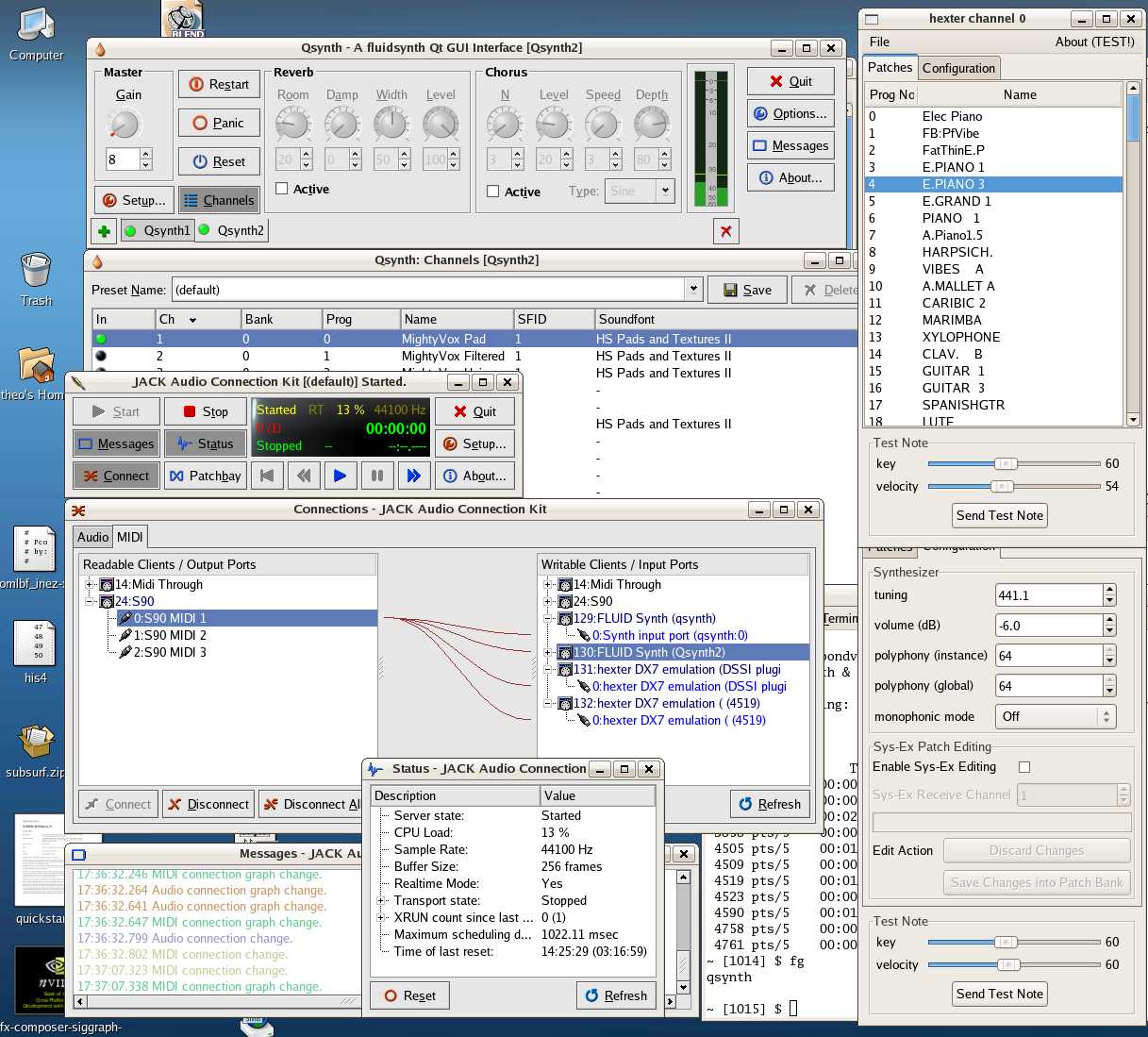
Because there is no precompiled version I think, I compiled Swami (the followup of Smurf)
for FC5, which can be made to crash but works normally, and allows the
editing under Linux of sound font files, which are samples with
additional data for SF compatible players, like KSynth. I downloaded
more than afew soundfonts, and there are even usable Steinway piano
sample sets out there on the web, and I made my own set of sampled
electric guitar strings which can be made to sound very good when
played skillfully, this is the SF2 file
which you may freely use to
your liking.
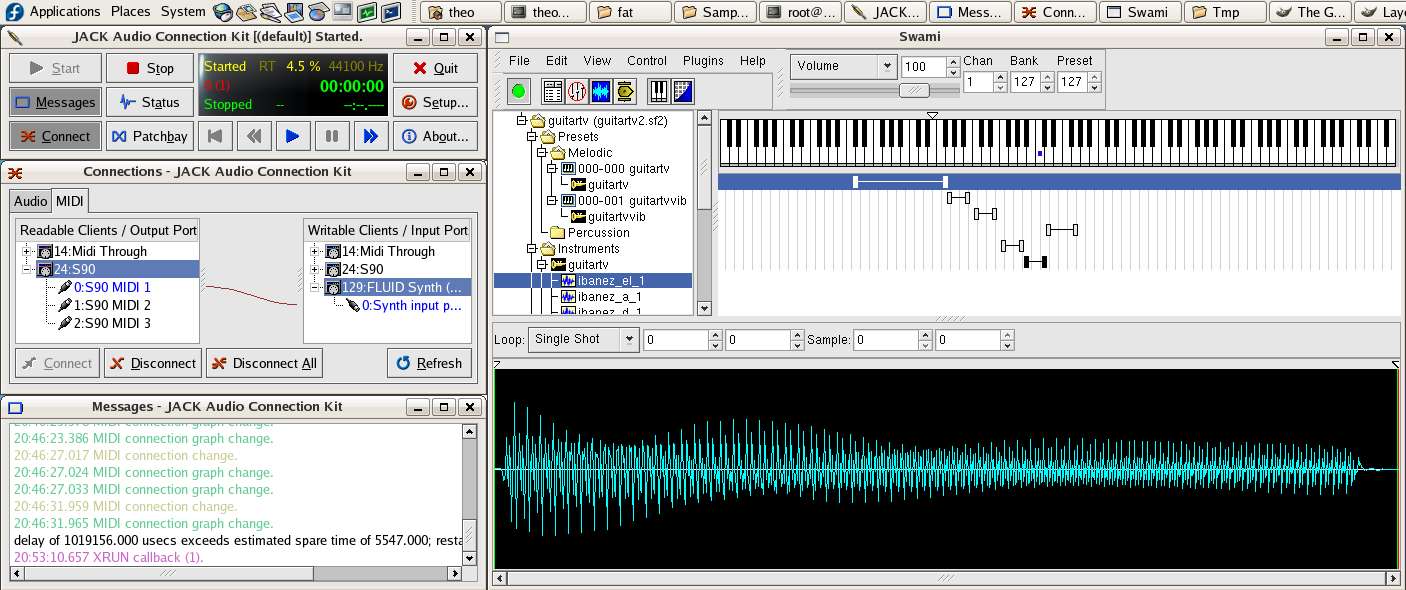
Powerfull stuff, Open Source and Free (as in free speech, not free
beer). The hole operating system and all the applications and the sound
generators and process plugins freely available with source code to see
and change what they do. Great, that's actually better than on the big
M$ ! Especially when the sounds are so much better, too.
I did have samba issues, meaning I used the graphcical interface
because mounting FC4 shares (samba shares) on FC6 didn;t work, fc5 did
however.
Binaural recording/listening lecture/demo
Cilia Erens (8 Nov 2006, NFTA, Amsterdam)
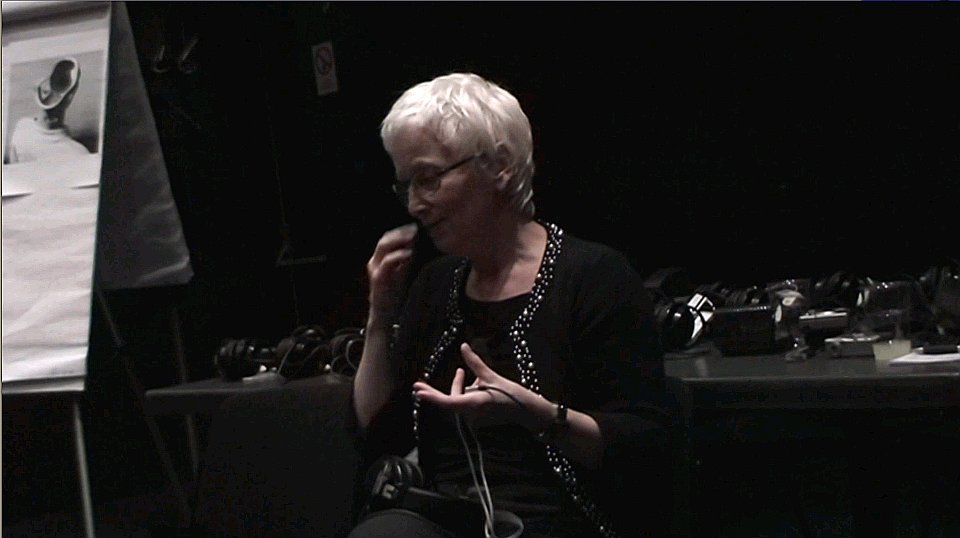
I was at this lecture for AES (AUdio Engineering Society) student
edition about Binaural soundscapes from sound artist Cilia Erens, and I
made a short HDV impression of the session. The picture above is a
edited version of one of the frames from the short film at about a
quarter of the size of the original frames.
I make the following files from a 3/4 minute HD film impression
available for any use as long as I am mentioned in the derived works,
in various formats so pay attention before attemptig to downloading
one, for the original for instance the server will need about 1/2 and
hour to let someone even with a DSL connection download it, and on a
modem or isdn probabky it would take you days or so...
binau1.mpg
144 MB The straight from the
1080i HD cam file, no losses except what the mpeg2 transport stream
couldn't get coded in 25 Mb/S
binau1_t.mpg 92
MB Trancoded over 1080 mpeg4, and back to mpeg-2 to
make for motion estimation smoothness and cinema type of atmosphere
binau1_720.mp4 17 MB A
HD720p (progressive) converted mp4 (comparable with .MOV) file for
Quicktime players
binau1_m.mpg
4 MB smaller sized ( a little over widescreen CIF or so) mpeg-2,
compatibe with many players for reasonable machines
binau1_m.mov
3 MB idem but coded in apple Quicktime playable mpeg4 .mov
format
binau1_ml.mp4
4 MB lower frame rate, better sharpness mp4, same format
I seem to recall I put decent audio tracks on mostor all of the video
filers varying from aac to mp2 probably. Note that the big and large
picture format files take huge computer power to play right, and all
these file are tested by me to be big error and stuck-frames free, so
jerkyness is you r player, not the file. Really, a pentium D 3 Ghz with
major graphics card and fast motherboard and disc CANNOT play the
biggest file completely motion error free, except maybe with a
special player I woudn't know about, I tried mplayer, powerDVD,
powercinema, media player, Quicktime, Realplayer, various Linux
players, winamp, and likes, the best works probably good self-compiled
mplayer on Linux, that can run the movies pretty well, but I'm quite
sure on certain motions and certain material it doesn't completey keep
up.
So how do I go about that except using an HD TV with digital connection
or so (which I cannot use) ? Well, there is one solution that works
real good, and thats hardware
accelerated media player, which luckily is fairly cheap to get
if you have a NVidia graphics card of recent date, in such case
download and install PureVideo from NVidia, which costs $20, and then
use a big enough screen (my main monitor screen can do the full HD
resollution of 1920x1080 pixels) and you can use only the windows media
player (XP or XP pro) to get absolute error free and jerk or block free
HD viewing, looking great, and even with motion compensation. A real
thrill compared with sit-and-hope-the-player-won't-yerk approach...
A fast contemporary computer should be able to play the 720 file quite
well either with quicktime (Mac or Windows) or mplayer (Linux,
Windows), which on a DSL internet link should download in 3 minutes
(still long for a under a minute impression).
So was the lecture and demo interesting ? Sure, nice to listen to a
sound impression, but unfortunatey the binaurals didn't work for me
except for sounds which seemed to come from the backside! Still good
quality recordings from farout places, monk dinners, hunting, asia, etc.
I think the idea of telling audio (and fim) related students about
traditional (unsampled is wrong term I need to correct here:
every iPod has a DA converter...) recording of good quality, and
of course the ideas of binaural recording, taking the audio effects of
the waves passing around the head to the ears into account, and the art
of making good soundscapes are important.
I can use a notebook with vety good AD on location, though thatis
pretty heavy and two cases, and maybe I'll find a way to put two
AT2020's on a beam or so for good mobile stereo recording, which gives
really excellent quality, but that makes the whole rig not exactly
close to light and easily portable (read: weighs kilograms).
Making HD 3D animations and combined Graphics/Film
What's that with HD? Well I like it in comparison with even high
quality 'normal video' recording, I used a pretty good digital (D1)
normal format video recorder for years, really quite a good one. A sony
upper mid range consumer cam with good picture quality, enough
possibilities, though I guessmore profi control dials would be nice,
and it made some good footage suitable for all kinds of use.
But taking (pretty much the only one which exists, together with only a
few others) a modern HD camcorder and making F I L M -like
material is something else. The lowest price available HD cameras til
recently,they existed already in the 80's, I knew about HD as EE
student, would probably be $40,000,- or something in that course range,
last year a more affordable one was introduced tough I think it had not
full HD actual resolution per colour, and this year Sony made a HD
(They call it HDV) camcorder as upper range consumer model, with which
I was able to shoot already a few hours of well chosen material for
practice and archive purposes.
And mind you, the resolution or the amount of pixels is about 5 (five)
times more than normal video cameras and their output data streams,
which is quite extreme, comparable with taking 25 pictures per second
with a 2 Mega Pixel digital camera of pretty good quality (for consumer
norms anyhow).
Assuming one has a player to play HD video at full 25 frames per second
(50 half-frames), there is one other way to create digital film with
such quality except with a scrapbook and a scanner: computer animation
with 3D models, and that happens to be an expertise of mine, 3D
computer graphics, I worked on making hardware to accerelerate
photorealistic computer graphics computations.
And I graduated as EE partwiseon teh subject, which I find interesting
and challenging. Well, technology had evolved (If that's the
word) since '91, and of course personal computers of now are more
powerfull than professional workstations from that time, so a lot more
computations can be done in this time, allowingmore quality and: HD
quality images for animatons without needing Nasa's compter budget and
2 years mainframe computer time.
Graphics cards too are of much higher quality and are starting to get
quite powerfull. So a modern 3D card can generate HD comparable images
at even 50 frames per second of scenes of fair complexity, certainly in
terms of tradional benchmarks, whcih is good and usable for animations,
but not for cinema quality or lets say decent enough HD content, than
various quality measures are harder to achieve.
So how does it work to get good quality 3D animations for those? Like
it has always been: by non-realtime or off-line rendering which takes
some time for each seperate frame of output, from seconds to hours, and
possibly speeding this process up by using a farm of computers. Also, a
graphics card, or more than a few together, can speed up frame
rendering, but than they must be suitable for high quality rendering
and the dat models one ants to use.
Recently NVidia, one of the worlds largest graphics cards manufacturers
made a language called 'Gelato' available which uses it's graphics
cards to do high quality 3D rendering fram text files with 3D scene
descriptions. The teapot below is an example of a 'virtual' model being
rendered with a certain lighting environment to an image:
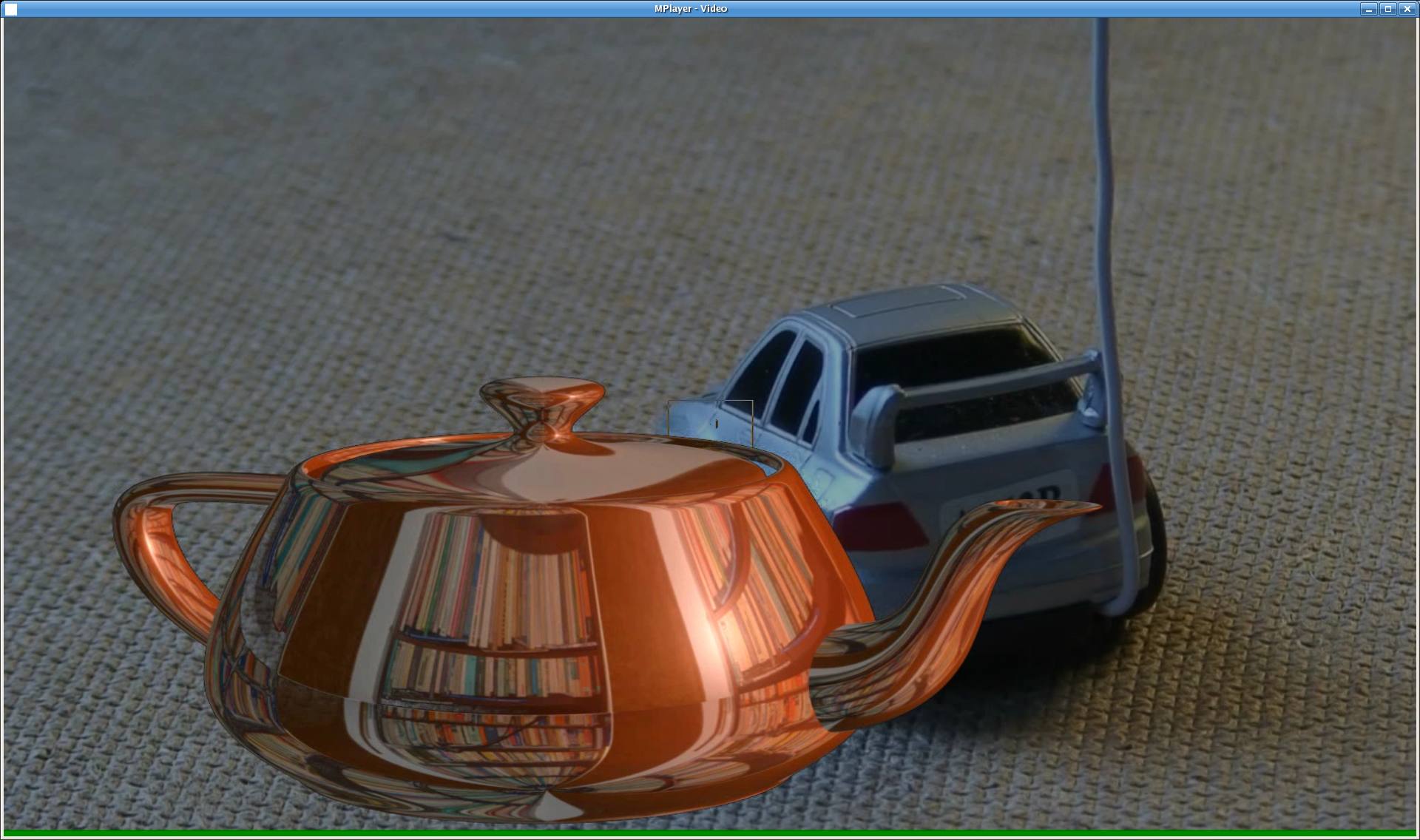
The teapot is a list of coordinates only, with surface properties
attaced to it, and it has received a image with its environment (the
bookshelves), which gelato has turnedinto a big image, using the
graphics card of a computer and the CPU together, in an overseeable
amount of time. It took that image and imported it into cinelerra (Yes
I typed cinerella because that sounds better too at times) and loaded
in a D movie of a small RC model car too, and I made the alpha channel
of the teapot image transparent, so it appears as if the teapot is on
top of the scene. In fact the teapot moves, ad of course the film of
the model car moves, too, which makes for a more complicated, composite
graphics and real world movie scene. The above is from an actual piece
of moving (test) movie, not a drawing program composition.
In movies or animations for movies, motion is important, which makes
frames exhibit 'motion blur': unsharpness of a certain kind because of
objects or the whole scen moving. Below the teapot is tranparent, and
the plane of the rc car is rotating, creating circular blur on the
plane.
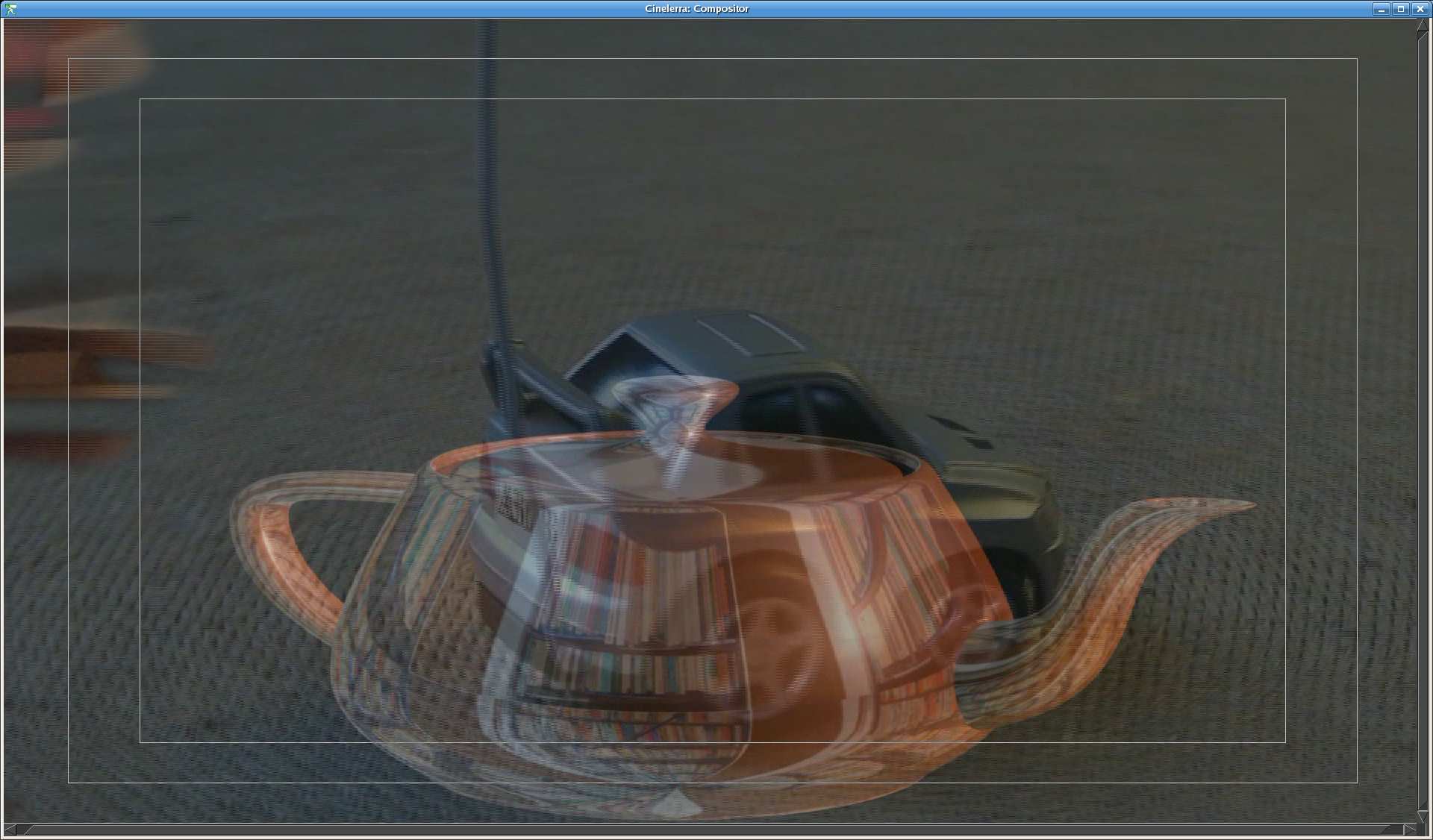
The above images were fram cinelerra a open source (linux) movie
editing program which is quite capable of dealing with HD data streams
and can process HD frames quite well given you have a sturdy computer
(read: d*mn potent). I made a tcl script which generated the right
gelato scripts with translations for the teapot, and I rendered a mpeg
file with the ffmpeg tool from the resulting pictures.
Pinnacle Studio 10.5 (can be bought from internet, for windows) can
handle High Definition content as well, I tried variou seffects out
with it and loaded the mpeg film result in Cinelerra (on Linux) and
used a cinelerra chroma keying effect to combine frames, the box with
glowing text is from Pinnacle:
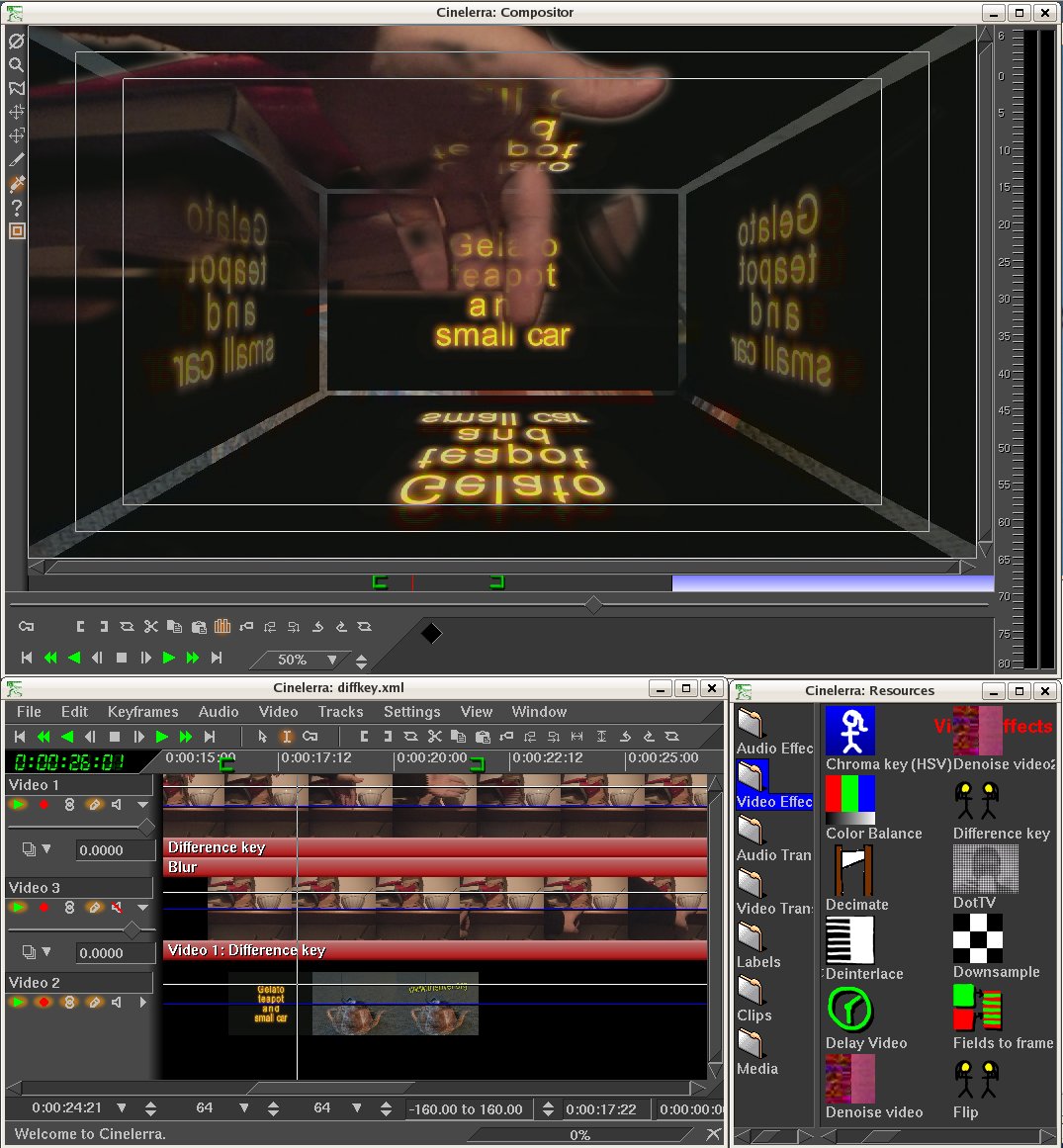
Of course cinelerra as used above with various effects doesn't render
these effects in full real time, while rendering a 25 megabit/sec movie
on the screen on a fast machine is possible at 25 frames per second. As
an advanced Unix program, Cinelerra has facilities for rendering frames
with a 'renderfarm' which is a set of computers connected over a
network which share the computing load together. A small experiment
showed a could achive a rendering speedup of 2 when using 3 machines
for one example.
Music from outer space
I've thought about making album music, and in a few hours have come up
with mulitracked ideas put into song prototypes about space
Alternatively I've made a short intro audio piece for SciFi film for
which I'm collecting thoughts. I'm not going to give away all
production thoughts but I think almost exclusively High Definition, and
am working on materials: space pictures, High Dynamic Range pictures,
3D models, and practicing editing of HD video and effects up to a good
standard and trying out blender (wich I have working with Gelato
hardware accelerated high quality 3D graphics) and other 3D packages
including OpenGL programming and (.pyg and C) Gelato rendering.
Maybe I should get some raw dat from radio telescope for artistic
purposes... Well, I had read most all of the libraries interesting
SciFi books at 13/14 or so and I still think the good (pre 80s) SciFi
was pretty uplifting and a bit eduational. Though I like stories with
women and lets say better athmosophere in it than "the third planet was
really good red, with gold stripes and it smelled like onions"...
Though the onions part would work possible, fresh from the spacecraft,
and then the smell of onions, well, ok. Against pigs in space and
spacefascism, which I detect around the latest space shuttle travels.
Remember those space outfits from Earth Wind and Fire and other 70s
outfits and backdrops in the style? And the cover of the commodores and
ELO
records.
That, and then more, and better ?
All the following songs were written, performed, recorded made
web-ready by me, feel free to download and listen, also publically, be
sure to mention the author (me, that is) also when 'borrowing' ideas
and 'samples', just like a grownup in music would. Use (right-) click
on the link and 'Save As' to save to disc in either uncompressed (CD
quality!) wav format or the well-known mpeg-3 audio compression format.
rock1 [.wav] "Never Rock 'n
Roll"
A protest song about nobody 'hip' ever seeming to have the
drive and the applied talent to make a rock song.
spacemp1 [.wav] spacemp1 [.mp3]
spacemp2 [.wav] spacemp2 [.mp3]
spacemp3 [.wav] spacemp3 [.mp3]
spacemp4 [.wav]
spacemp5 [.wav]
The above are quick recordings with an album idea in it. Not a techno
one, but more like a traditional high level idea one.
spaceship1 [.wav] A short
introduction piece intended for a movie where an alien space ship
arrives, and the narrator (me) comments on the picture and sound
(picture doesn't exist yet).
The small TCL script for making the links:
foreach i [lsort -dict [glob Ldi36/*.wav]] {
foreach k [lsort -dict -decr [glob [file rootname $i].* ]] {
set j [file tail $k]
puts -nonewline "<a href=\"$k\">[file rootname $j]</a> \[<i>[file extension $j]</i>\] "
}
puts "<br>"
}
These songs sound especially good on a (big) good quality audio system,
24 bit recording and mastering was used.
Future aimed electronics
Mostly electronics and electrical engineers are future aimed, I think
that should be in their genes or something. However, also in EE the
bookkeepers and the motherf*s have taken over more than is healty, I've
been a witness of that process myself when I worked in Hollands top
university (no exageration) in the at the time still top section of it,
normally speaking: Network Theory at te the dept of Electrical
Engineering in Delft University, theoretically founded at the
foundation of about half the faculty of EE (minus mainly
electromagnetics) at the time the only section in Holland going for
serious VLSI design including mathematical issues, strong computer use
american style: unix, every student should be proficient in C.
I think not everybody was up to the standard but it was a high level of
students and their work, though it started to decay. The only reason
for that was american science and knowledge without a doubt, and
already when I graduated a lot of the things going on were bogged down
by sort of an IT approach which was way to big, or people simply
wanting a piece of the computerpie without taking them as scientific
tools. Also, the american infuence (the professor was a Stanford EE
PhD) was getting less fundamental, network theoretical issues were not
tended much to, and management was probably more an issue than actual
science and scientific skills. And then influence of the official
people wouldn´t help much to get bright people to work there or
to work right, like system manager aren´t scientists and
inventory keepers aren´t professors, and students aren´t
supposed to be chosen for being played against eachother in some stupid
papal or non-machiavellian orthogonalisation ´process´. In
other words: the new age tried to rule, and probably the abundant
evilness at stake was too much to bare for the good people. Probably a
long story.
Well, I was already quite into electronics of significantly high level
in highschool, in various ways, and I was interested in VLSI design for
sound synthesis purposes when I chose to do my laboratory task in
Network Theory Section after having been invited there. Also, I was a
student assistant in electronics for years.
As I´ve written I´ve been doing all kinds of electronics
designs and prototypes the last years, recently these include working
with a Xilinx Spartan 3E500 FPGA demo board, programmable with a
notebook over usb, a
tiny low power ti mps430 microcontroller with built in high resolution
AD converter as part of a programmer usb stick also programmable with C
compiler ono a notebook.
Before the MILE2006 musical instrument fair where I was to demonstrate
my synthsizer and audio hardware, I could make a new additional
amplifier, which became a quadro (four way) or double stereo amplifier,
for multiamping purposes, with significant power for the main stereo
amp, and similar high quality but on purpose limited power for the
secondary stereo amplifier unit.
Funny enough, I got almost all the parts from Conrad, over the mail,
which has just recently become free! See below picture for most of the
parts before being used and built in:
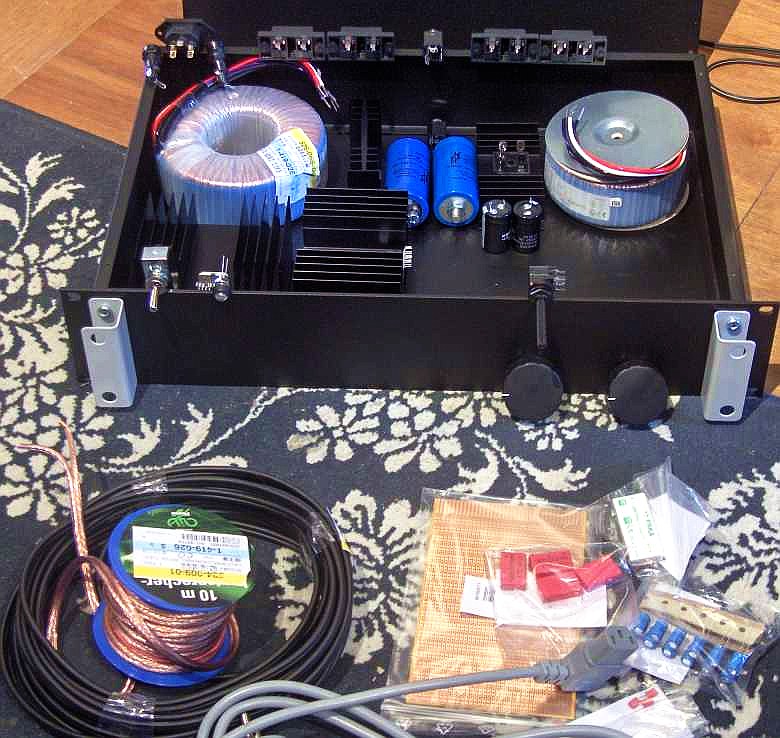
Two big toroid (round) supply transformers, 400 and 230 Watts, two 25
amp rectifiers with heatsink, 2x10,000 uF and 2x4,700 uF 63Volt
capacitors, chosen for very long life when used with sort of 3/4 of the
maximum current load and not more hot than 55 Degrees Celcius IIRC
(Something many electronicists may not find easy to take into
consideration, but nowadays these issues are in datasheets on the
internet). Clearly visible the main heatsinks, and the 4 chip
amplifiers, the knobs and potentiometers, heavy on-off switch, the 2
unit 19 inch rack unit, the high brightness power LED with holder wit
dispersion lens, which uses only a very small current to glow bright
white ´ON´ light taking a very low percentage of the rest
current but still is fed by the main supply of 86
Volts rectified voltage to see if that voltage is there and stable.
And then the electronics parts, very good quality capacators for audio
purposes, and supply capacators with very high surge capacity, lower
quality elcos extra slow fuses with holder, a euro cord with connector,
shielded cable with 2 cores for grounding design, metal film resistors,
and 2.5 sqmm (!) fine threaded (against skin effect) wireing cable, and
general purpose medium thick medium island printed circuit board, and
of course 1/4" jack input parts and speaker connectors..
First the double supplies and one channel and the mechanical montage
and drilling and sawing:
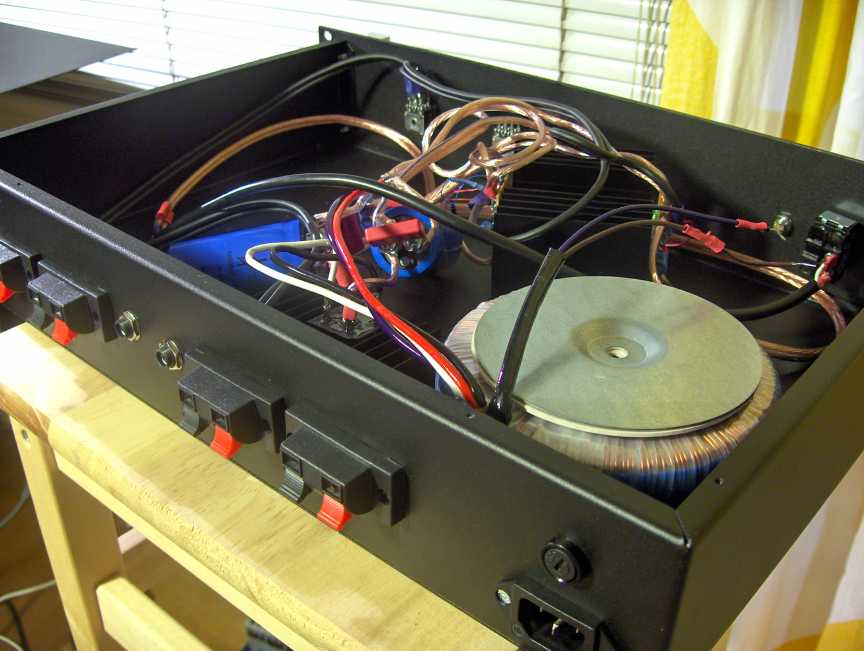
Then some good testing and measuring, and the layout of the second
stereo amp, with attention for hum prevention, and the fixing of the
electronics on the bottom plate and making sure the wiring is free from
the heat sinks and the isolation from the main heat flow:
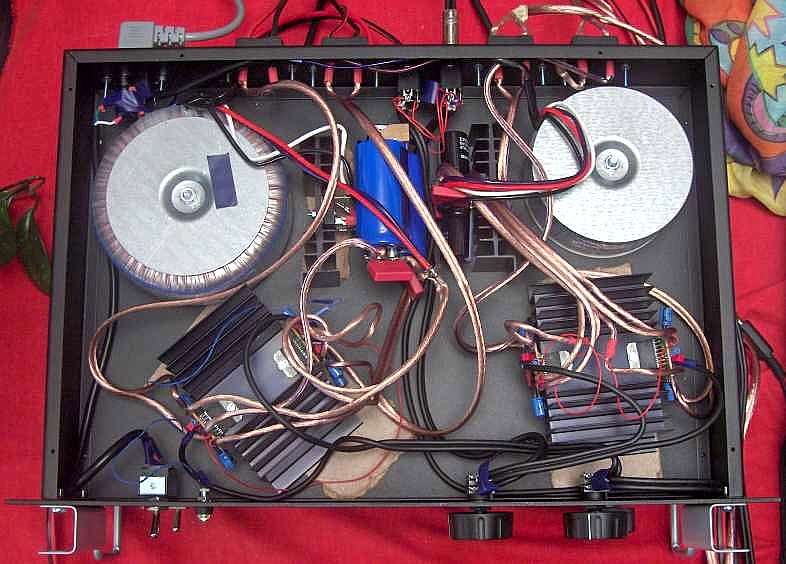
A quadro amp finished in 4 days (really, you can ask Barbara 4 days
after I got in the parts it was actually playing), including partwise
design and mechanical work, and ready to use:
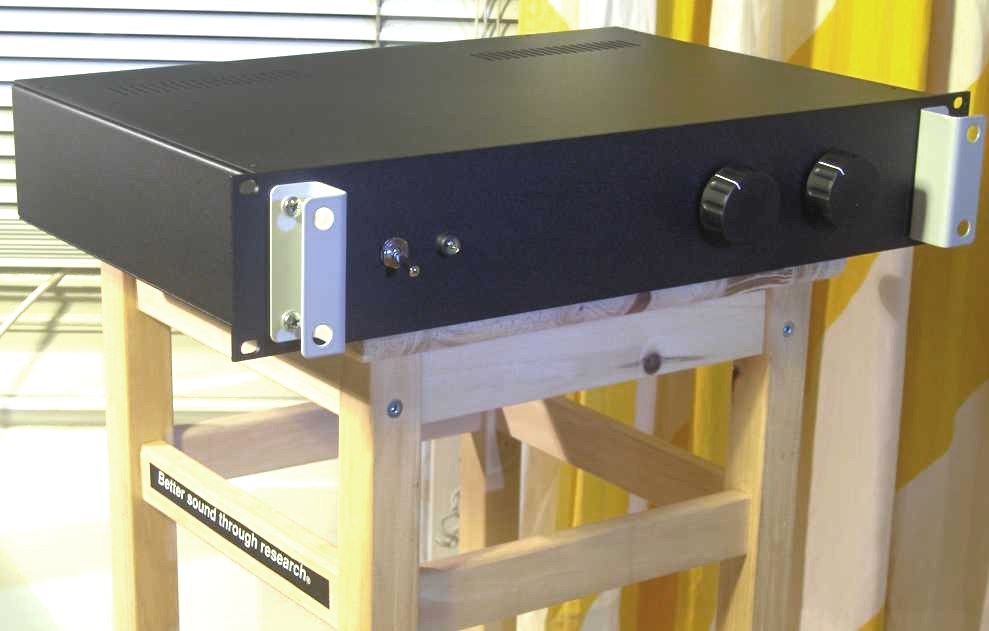
So what does it do? It has 2 stereo amps, one of 2x100 Watts RMS
continuous, and one of 2x50 Watts RMS cont. in one case , with
completey seperate signal input and outputs and grounds, but with one
on/off switch and fuse, and no switched supplies at all, so quite good
seperation from main and ground noise free. The lower wattage is to
prevent smaller speaker, in my case small mid-hig paper cones from
getting possibly way to much power, so that they don't blow up too
easily.
Also, the supplies are rather massive for that amount of power, so peak
power could be 750 Watts, if you feed it near-square waves, and music
power is at least 1.5 times the continuous rating without any exessive
supply heating or exceeding of rated maximum power for the
transformers. The capacitors on the main amp supply are also pretty
large. And you may remember that these TDA chips are very high quality
when used right, 0.005 (mind the 2 zeros) percent harmonic distortion
at significant power
is very good, and there are (bootstrapped) mosfet output transistors
for nicer high power behaviour and probably current sensing in the chip
(max 10A per channel) and the circuit is a real OpAmp circuit with very
short (maybe 2 cm loop from output FETs to over feedback resistor to
inverting input) feedback loop wiring. Also the chips have built in
temperature safety which diminishes output power when the substrates
become hotter than 150 degrees Celcius, and the design is such that the
whole heatsink may get that hot when really necessary, then nothing
really melts or burns, in principle...
In normal use, as I knew from the previous similar stereo amp build,
the heatsinks don´t even become very hot even when used to make a
REAL loud noise, I mean like playing disco for half the street loud...
And the power without much loudness (soft room use) is about 27 Watts
of normal transformer load for 6 channels in total (including the
previous main amp which is now sub woofer amp).
It was sort of interesting that only a few days after the amp was built
an dfinished, it got to be used as part of my main speaker setup to
demonstrate my synthesizer and speakers, and of course the amps too at
the largest dutch musical instrument fair, where it blew its hundreds
of actual watts into a not so small space without any question as to
its capabilities to be heard good and at extremely high quality for
such a loudness levels.. A good testg of my amp building capabilities:
it was used as the main amp for the main speakers throughout 2 full
days of loud (and softer) use for publically amplifying synthesizer
basses and licks, a digital piano, a sampled drum set at life volume,
and music for public (demonstration) listening from Tower of Power to
Classical from a Chesky sampler CD of high quality recordings, and from
Rolling stones to film music.
And, did it break down, or come to a steaming breaking up? No! It
performed beautifully and cranked out a lot of watts without becoming
more hot than a little bit, and worked flawless and very good. In fact
more tranparent, light but very loud and undistorted high range, and
better controlled and loudly formed basses and clear and unmessy
midrange than most people probably ever heard coming from even a very
expensive high end stereo system. I´m serious. And probably
thousands of people should be able to testify to that, I mean this was
no closed session with only friends, man.
And also in its normal use the system has become more beautyfull and
straight and capable then ever, because I now use a tri-amped main
speaker setup, and replaced the car-booster for the subwoofer with the
previous main amplifier unit in bridged mode, and the new four channel
amplifier as main amp and seperate mid-high squakers amplifier. So 3
stereo amps for the main speakers and the main subwoofer unit:
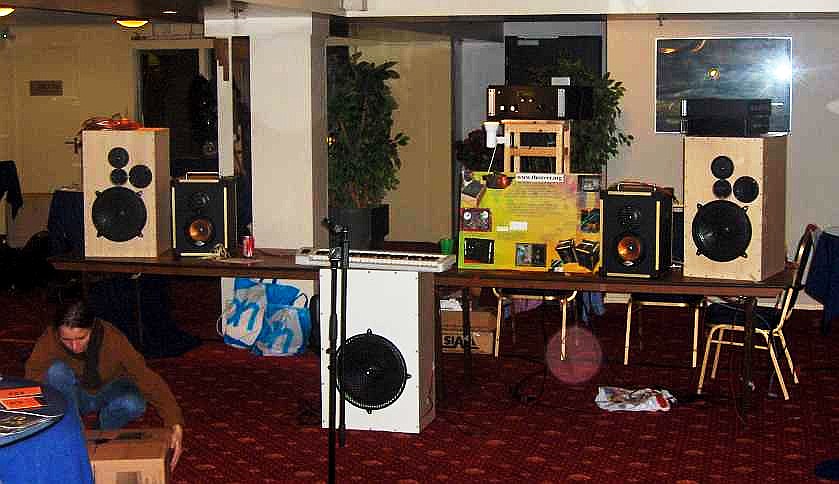
Most
of the setup used at the MILE 2006 musical instrument fair
The new amp is on top of the pile of two amps on top of the right main
speaker on the picture, and this is during buildup or cleanup (I
forgot) of the second day (that's why all the wires are cleaned up).
To make this setup possible, the following was needed:
* electronic seperation filters for 2 main channels and sub
* very high quality pre-amp and drivers
The sub amplifier requires a phase inverter as well, because it is used
in bridge mode. The filters are based on very high quality operational
amplifiers from Burr Brown / Texas Instruments using selected high
quality capacitors and metal film precision resistors, and a well
stabalized supply. They are second order filters for the main part, the
mid highs have a spilt frequency filter on the low frequency side (4
kHz) and as exception a 1st order filter (at 8 kHz) for high-off
filtering, which is complementary with the low off filter for the above
8 kHz heavy dome tweeter.
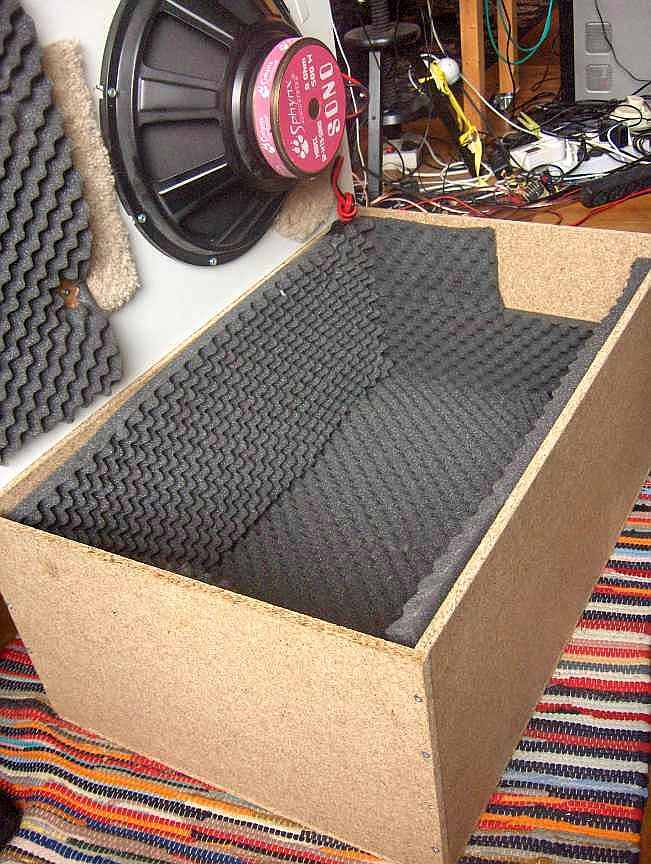
To greatly improve the quality of the sub woofer I had already in use I
added a fairly big enclosure to the existing bare frontplate (of 18MM
MBF-like wood), with a lot o fbig screws, airtight edges and damping
material all over the inside, including extra thick carpet patches to
further reduce stadning waves, and to counter the resonating of thw ood
of the back pannel directly behind the huge 15 inch woofer. To keep the
weight managable and as a trick to dissipate a bit more power through
slight bending of the wood I used only 12 mm 'spaanderplaat' for the
rest of the bass enclosure.
So what do I test my setup with for isntance? Well:
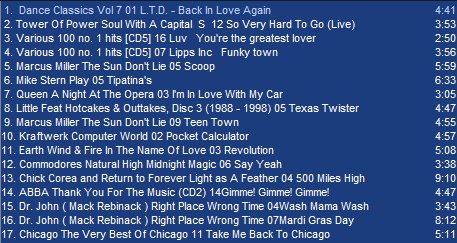
On a funk day, that is. I used test microphones, pure sinewaves
and even whitenoise, too.
National Intruments
I visited a meeting of National Instruments, a measurent and control
type of EE company which invited me to a demo of their equipment, kind
of fun, a rack full of degitisers, drivers, actuators and processing
stuff, liuke control systems for motor control, temperature alarms, a
camera which can compare items on a conveyor belt with a specimen in
memory, and of course everything can be linked up with a computer, no
space age stuff but still fun.
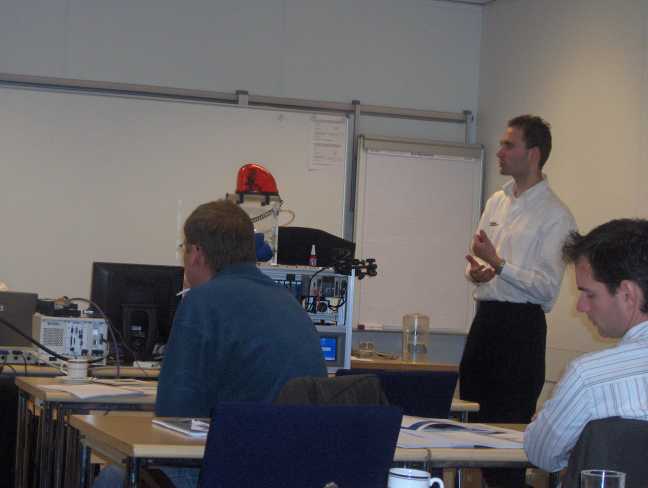
They had a FPGA (programmable logic) on a card with Inputs and outputs,
which could be programmed with a diagram of a control circuit being
processed into a fgpa 'program' by LabVIEW. Just a pity that I could
easily run the same program on a PC with a serial cable when workload
and required IO bandwidth were required. Principle is principle though,
maybe I should make some more automatically generated FPGA programs.
"Electronic" Music ?
As a kid in the 1970's I associated electronic music with lets say
commercials, film effects, Star Trek and such and with artists like ELO
(Electric Light Orchestra for the musically illiterate...) Garry
Newman, and for me at the end of 70s with various acts with
electronical elements in their music, Walter Carlos, Depeche mode,
Yazoo, Human League, OMD and such.
Probably the first song I'd have known to sound all electronically,
that is with synthesizers only would have been 'Popcorn' at least
that it was called in holland in the beginning of the 70s probably it
was "I love Tricia" in the good ol´ US of A.
While I was at the musical instrument fair this year (with a stand,
that is), I got as one of the visitors some guy fro the Hague who was
organising another fair (in fact I was more like on a tradeshow) who
said he was impressed with my setup (the prottypes I showed) and wether
I was interesting telling or showing something to his 'electronic
music' fair for dj's and musicians. Well, such things cost money, and I
have none, so that is not easy, and honestly I was'n impressed with the idea, I
mean 'Musicians' and the kind of 'dj's' which 'play' modern music, nah,
tat is no combination.
DJ's were already not my highest bet when I was kid in the 70's,
I mean they were usually compensating a lack of justified ego by
speaking through good records and as compensation they have to be a bit
nice and praise good music anyway. Some would be good and cool and make
a real show out of playing popular or danceble records (I was in a sort
of student disco for a couple of nights a week for years where that
wasn't really the case, but stil its kindof fun) with a good buildup,
sensible anouncements, maybe some effects and good audio quality and
choice of songs. That was pretty cool and desirable. Our school disco
in highschool (I knew one of the guys who built it from a sailing camp)
which was like loud enough to have to shout to another person at at
most 20 cm distance or they couldn't hear a word you say, 500 watts at
the time IIRC and big 15 inchers, great fun, had no anouncements at all
much but great music, light effects, etc, like the 70's top of the pops
things but loud and crowded and not too dandy music. Great fun.
I played DJ with my self made mixers and speakers and electronics long
before that in primary school, more like on the radio, which I thouht
was great, too. Later on in highschool I had a (tiny powered but high
quality sound) 'illegal' FM radio transmitter which of course I had
built myself, and even a full duplex link I built which I used with a
friend of mine around the block, where of course DJ-ing was a daily
matter. Also great fun, though it would depend on the musical taste of
the listener.
And musicians are 'higher' in the musical hierarchy of course.
Home-recorder who don't play an instrument and try to make songs by
doing things the latest style by getting some samples from 'real' music
and motherf*ing around with a lame drumcomputer and some obligate
'singing' chorus effects (the guys who invented modulated delay lines
did a lot more interesting things with that idea back in the 70s) are
not more interesting thanan ordinary DJ playing good music and minding
his or her audience.
Anyway, I tried to email the guy back in decent language that I am both
a musician and high quality audio equipment maker and that I really
hate the new-age modern rap-house or whatever they want to call music,
but in nice words, and he didn't even bother writing me back, I gues he
was more important and to busy because he had to organise some fair in
a hotel lobby.
Well.
What strikes me is the claiming nature of the whole lets call it
´house´ thing for the moment, like everything will be
consumed and burbed out of the great house-budah and has than the
required bar-code of ´this is realy sh*tty cr*p that everyone can
recognize as such´ and so it should be and everbody is happy
shining people now. Barf. What a great poorness compared to for
instance 30 years of billboard number one hits from 1955 to 1985. Or
compared with anything half decent in the amusement or karaoke music
scenes. Only to make a mark of darkness and to threaten everybody and
everything that would be nice, truthfull about something good, or free
lyrics instead of a big mess of a sound wall which nobody really likes.
Radio stations are getting back to real music at times, which is good
news for people and teaches teens better things exist. I guess
people´ve been reading me..
In Sound On Sound I read a series of articles (just one or two in fact)
about people getting in touch with a ´professional´
producer from the magazine for some piece of recording or a mixing or
production problem, and of course there had to be the sort of new age
fake r&b in there and I couldn´t resist the idea of checking
out the production files which could be downloaded from the
magazines´ webserver as mpeg audio files. Here´s an
example, which is called VocalRepeatEdit.mp3
I forgot which magazine and the Url´s aren´t on the machine
I´m writing on (so you´ll have to google or pay me as
writer to get more profi attitude...) but this is probably a piece of
the sort of bad-imitation disco hit being discussed which has been
edited and possibly some effects added to it, to beef it up.
What a waste to beef such material up it is flat one-dimensional.
uninspired and fairly untalented to begin with, like all the other
music imitations in the genre, even the big names exhibit many features
of such nature, quite likely on pupose, too.
I mean a linn drum and a prophet-5 with arpegiator and a big sound
system are complimentary (in fact I don´t know which instruments
were used exactly) to a voice like Diana Ross or even Donna Summer, and
when both are good, excellent results are worthy of playing loud for
large crowds. If either is not so good, maybe the result is still ok,
but when the music, the instruments and the people playing or singing
are all mediocre and meaningless, what will the result be if even the
music style (which really isn´t music in my opinion) is so
retarded and miserable.
I guess its a mother-surprise bag of big-boy production dreams
´used´ from 70´s or 80´s stars which supposedly
make every other joe or jane sound like a million bucks.
Yack.
Theover doing rock music remastering
Some months ago I got a request from the owner of a studio, which was
commercial in the 80s, to try to patch up some of the recordings made
with analog equipment, multitrack and mastered on DAT (Digital Audio
Tape). The assignment was to make it more sparkling and with some more
maybe life to it, and of course to monitor it right, to get the levels
and the balance of frequencies right.
So I went to work with a CD of files, got the songs of, listened to
them, and thought about what they would need when listening to my main
monitoring system or on the biamped medium sized monitors. Most of the
songs were Rock or pop and some jazz, made of traditional drums, bass,
guitar and singer(s) with added brass and synth. The recordings were
well made according to mostly americanish ways with decent equipment
IIRC 16or 24 track Fostex multitrack, a good mixer, for the time wanted
compressors and effects like lexicons and expensive microphones, so
interesting enough.
I did mutitrack recording in the 80s, too, but as homerecording, and on
a much lower budget, except for synthesizers, those I had a
considerable setup of. I started doing (rock) band amplification first
grade highschool, to begin with on a small setup: the Tandy PA system
(80 Watts, 4 channel of mixer, small set of speakers), but with time I
did more there, and I was the leader of the technological commitee for
years, later on working with sennheiser MD405 (or what was the exact
number: the well known dynamic mics) a good brand mizer, yamaha amp,
and bose speakers, which was fun, and in the meanwhile I had built my
own 2x75Watts amp and fairly good speaker set, and mixer which at times
were used for PA-like work. Later as a student at university I got to
do band performances myself, I played keyboards in a top-notch Jazz
Combo for years, played various gigs, started a short lived band myself
(girl-singer, guitar, bass and drums and me on keys), was part of a
sometimes commercial pop-funk band for a while on request, and joined
the pop-workshop of the universities' Muzisch Centrum for a year (I
seem to recall). Also I composed and synthesized and edited score music
and the recorded audio for a student made video, and did a project to
make a good sounding popular dance song with at the time a friend of
mine, incuding drum computer, guitar, synthesizer, and vocals, on the
centrums' multitrack (Fostex). That apart from my home setup with not
so cheap condenser mic, high grade 3 head cassette deck, a considerable
synth setup (Yamaha TX802, TG500, RX-15, Rev-7, Roland HP3000s, Kawai
portable keyboard), an 8 channel mixer (subbrand of D&R, pan, dua
effect send, eq per channel, VU) my self made mixer (4 ch stereo, good
Q), a Kenwood 2x85 Watts amp, and two Yamo 504 (or 205, or what was the
number, wel known medium sized two way speakers with neoprene around
the dome tweeters, and those subtle leak slids around the not so small
woofer, and a LOT of power output). I also owned a Atari ST with 1Meg
memory, a harddisk, various monitors, modem, etc, with of course MIDI
software like from Steinberg on it, and in fact my own midi software as
well.
Well, of course it is interesting to mix, or as in this case, remaster,
g ood quality audio recordings and works on my prototype speakers and
amplification and high quality DA converters, so I went to work with
two versions of Nero Soundeditor's high frequency regenerator plugin
after destilling the songs from the files from the CD, amd I found I
could certainy make the DAT masters sound richer in the high frequency
range without destroying the feel of the songs and without getting a
distorted or grainy sound. Than I converted the result to 24 bit and
imported the tracks into Cubase LE which came with a Lexicon Omega
AD/DA converter which I used for monitoring, and I started to work on
light equalization of the tracks, added high (hard with the cubase eq
for over 15 kHz), and some low lift.
Next I extracted the midrange and the low range to seperate tracks and
applied some compression, and mixed the results in, and added some
tube-amp simulation effect and a touch of chorus to the low, in very
varying amounts for the various songs. Also, I gave the main track a
touch of (24 bit) reverb from 2 to 3 different Lexicon Pantheon
effects, mostly a combination of plate or reverb with another reverb or
a moderate room reverb, but only very slight amounts, to bring just a
bit more ambient and sampling life to the DAT recording.
The low boost wasn't needed and only in a few cases maintained by the
maker of the tapes, the rest made the music sound better and quite good
enough on varying speaker systems.
The production sounds sort of like this (I took the liberty of
mpeg-izing a short piece, 30 sec, of one song), use right mouse button
'Save Target as" on windows:
track10 in mp4 format
726kB , "quicktime for
linux" efficient good sounding, can be played with quicktime player
track10 in mp3 format
956kB , "mpeg 2 layer 3"
standard audio encoding of fairly good consumer quality
track10 in low bit
rate mp3 180kB , idem but
faster to download (for instance live 56k6 with modem) and lower
quality.
Can Theover also do rock himself ? Of course, though a band and analog
compression usually give different results, in fact I made a movie in
france a while ago where I played rock on stage (as bass + keyboard
player in a two time rehersal band). Recently I recorded this sort of
rock song I made and recorded myself only with synthesizer and voice,
using pretty good equipment, but I took only maybe an hour to do the
whole recording, including looking up the lyrics on the internet:
Never Rock 'n Roll
real CD quality wav (uncompressed, 16 bits, stereo,
44.1kHz) 8.74 MB
(C) Theo Verelst, may be used non-commercially, but not
reused (like samples or so) for derived works, only as it is.
I cannot be booked at the moment (unless it would be in the US, so that
I'd have to go there..), but I'll do recording projects or film
scoring, a Kurzweil would be nice, a automated mixer is in buildup.
For closers of this section, song
text from an old favorite of mine (which I can of course play) by
the main pop/new age man Joe
Jackson:
(Joe Jackson – vocals, piano; Gary Sanford – guitar; Graham Maby –
bass, backing vocals; Dave Houghton – drums, backing vocals)
Big shot, tell you
what
Tell me what goes on around here
Go on and get me in the corner
Smoke my cigarettes and drink my beer
Tell me that this world is no place for the weak
Then you can look me in the eye
And tell me if you see a trace of fear
You gotta look sharp
You gotta look sharp
And you gotta have no illusions
Just keep going your way looking over your shoulder
Okay, what you say
Tell me what theyre wearing this year
Go on and laugh at me cause you dont see
That I got something going right here
Say Im just a dreamer
Say Im just a kid
Well ace, shut your face
Maybe you will see or hear
You gotta look sharp
You gotta look sharp
And you gotta have no illusions
Just keep going your way looking over your shoulder
Big shot, thanks a lot
Gotta go its getting late
I got a date with my tailor now
Thanks for putting me so straight
Tell me how they run the crime down every street
But check your watch and wallet now
Before I go and youre too late
You gotta look sharp
You gotta look sharp
And you gotta have no illusions
Just keep going your way looking over your shoulder.
photons per pixel
From highschool we know that light has a dual character, it is composed
of particles and exhibits wave properties as well. For large scale
measurements, neither is normally very important: light is like a
continuum of radiation of whatever precise constitution, and simply
goes in straight lines and illuminates things so we and cameras can
observe a piece of space and its contents. SO a light paritcle, or ray
or little wave packet, or major amount of wave spackets together
forming waves through 3D space start from a light source like a lamp or
the sun
http://www.micron.com/innovations/imaging/lux
Well, uhm, I was thinking and seachingon the web a bit about this
important subject, and I'll make text about it later.
clock chip Fox board
Remember the Fox small Linux board with 100MHz processor on it where I
compiled the whole linux for which makes it tick with ethernet
webserver and such? Well, I ordered a sample from Maxim for a rea time
clock with a certain serial interface, which I received (little boc on
the right):
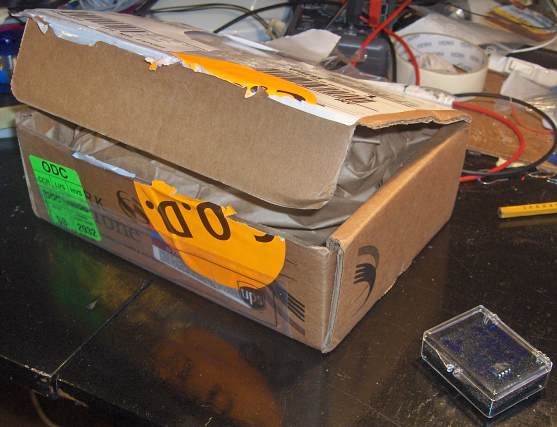
I tried it out (its a sample, so that's what its for) by building this
circuit (from the ACME site)
on a breadboard:
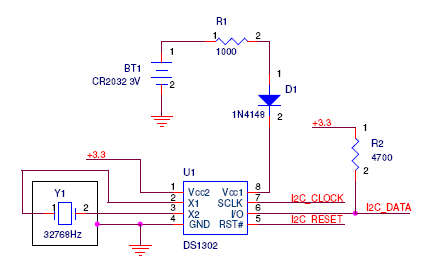
and now the board can be turned on and off and on again, and it will
have the actual daytime automatically in Linux, and timestamp files
correctly as independent unit.
Free and Open Source HD Film
I can't be the first anymore to make that, though this is an animation
movie, while I probably did more effort using recorded (HD) movie. As I
explained, HD means High Definition, meaning a lot of pixels are
recorded for each frame, its like a 2 MegaPixel digital camera of high
quality, but then at 25 frames (or 50 half-frames) per second...
This frame is from Elephants Dream
which can be freely downloaded, though of course in the very high HD
resolution it requires a huge download (815 Mega Bytes, or more than a
CD full) from here.
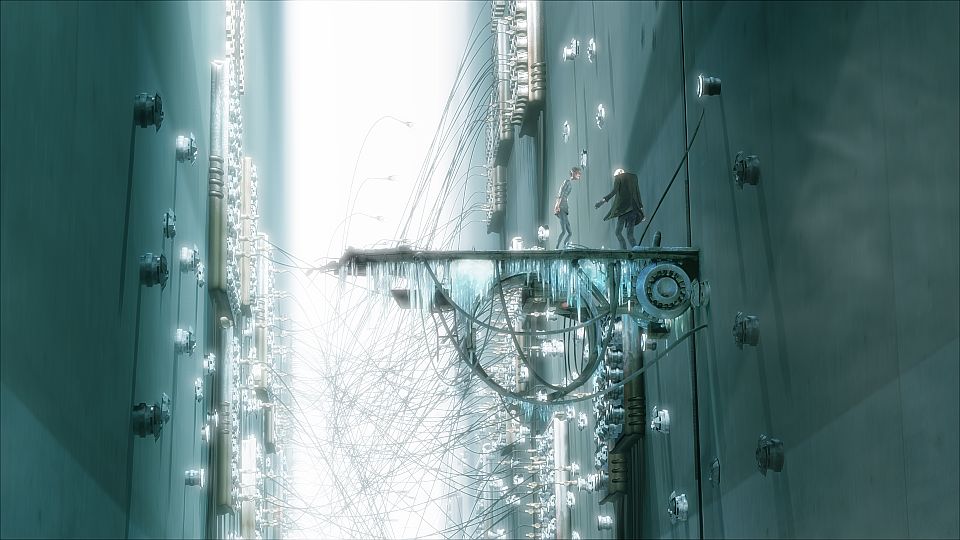
This is the site from the organisers of the half year
proiduction challenge: orange.blender.org which is part
of the blender Open Source and Free 3D rendering package site.
In fact the Open Source side of this movie means indeed that it is
claimed all the files, 3D models in .blend format, processed frames,
testures, etc, are freely available. This deserves a big cheer, so CHEER!
I did notice that I couldn't in a short time get blender to render the
provided 3D sources into something even near the look of the final
frames as shown above, and mind you, that above frame is only a quarter
of the size of the frames in the movie! Click it to be pointed at the
original frame in fulll resolution in png format (1.8MB), and al
frames are there.
I didn't find out how much drawing and postprocessing and how much
specific bender rendering and animation knowledge is needed to get from
the 3D files to the final frames, but it must be considerable, maybe
that part is NOT Open Source. So at first glance it seems this project
is not suitable to learn or teach a working animation workflow from,
but its great to see a free animated HD movie about a heavy subject...
Everybody is free to keep that for themselves of course.
The company of films
Some films have a good presence when viewed, either along with some job
or hobby, or as a feature film with things to say and good enough
story, technology, liptalk, soundtrack or what else is there.
Viewing films makes me think of making them, especially when I see more
than a few good mostly american ones.
When working at university (a decade ago by now)
Oh, and get those good ufo movies coming on the internet, especially
when they work really good and are not known to be a hoax.
Alternatively, I looked at a movie about a kansas situation ("The crude
oasis" with Jennifer Taylor, Aaron Shields, Robert Peterson, by Alex
Graves) which also felt nice and spacey in some sense. To really not
feel sucked into big brother continent and the land of hypocracy and
free from all kinds of miserable social and film-technical conventions
feels really good in comparison, for instance before sleeping.


















